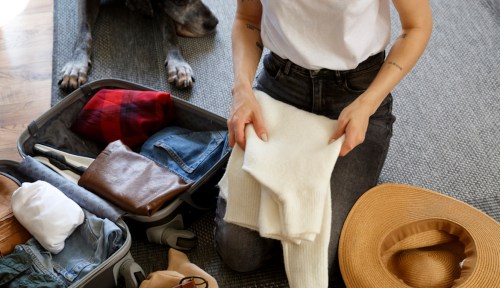If you’ve traveled this summer, you may already know that the summer 2022 travel season has been described as a downright nightmare due to an increase in delayed and lost luggage caused by airport staffing shortages. The easiest way to avoid having your luggage lost: Don’t check a bag. That, of course, requires your carry-on packing skills to be on point to ensure you can fit all your travel essentials in one bag. Most importantly, though, you must also be informed about what you can and can’t pack in your carry-on. To help with this, we turned to Cheryl Nelson, a TV host, certified broadcast meteorologist, and travel preparedness expert.
Luggage size limits may vary slightly from airline to airline, but the most common limit is 22″ x 14″ x 9.” Now that you know that, learn about the not-so-obvious carry-on rules and guidelines you may not have heard about—but definitely need to know before boarding.
1. Know weight limits (and if you can lift your carry-on)
Travelers often focus on the size of their carry-on luggage and neglect to think about the weight. Nelson notes that many domestic airlines don’t have a carry-on weight limit, but some do. (For instance, Frontier Airlines’ carry-on weight limit is 35 pounds and Hawaiian Airlines tops out at 25 pounds.) Weight limit for international travel also varies, Nelson says. Her best piece of advice: “Always check your carrier’s website for specific airline carry-on rules.”
Regardless of weight limit, Nelson recommends ensuring you can lift your bag high enough to get it in the overhead bin. “When I was a rookie flier, I used to pack so much into my carry-on bag that it was almost bursting at the seams,” she recalls. “I didn’t realize how heavy my bag was until I tried to lift it over my head to put it in the overhead bin. Thankfully, some kind passengers assisted me, but this won’t always be the case.”
2. Know what counts as a personal item
In addition to carry-on luggage that you can store in the overhead bin, you can also bring a personal item with you. “A personal item is a small possession such as a purse, briefcase, laptop bag, tote, camera case, or small backpack, as long as it fits securely under the seat in front of you,” Nelson says. “Basically, think of it as a bag, not luggage.” Restrictions on personal items may also vary by airline, so again be sure to check your specific airline’s site before your trip.
3. Put liquid makeup in a clear, quart-sized bag
While many of us are familiar with the rule of packing all liquids in travel-sized containers (3.4 ounces or less) in a clear quart-sized bag, you may not be aware that some of your makeup products must go in the bag to prevent them from getting confiscated by TSA agents. “When packing makeup in your carry-on bag, always put your mascara, lip gloss, liquid eyeliner, liquid foundation/concealer, or any other creams, gels, or aerosols in your quart-sized bag,” Nelson says.
Some airports may be stricter with this rule than others. “In my experience, when I fly internationally, I’ve noticed that security agents will flag a lot more items,” Nelson says. “Most of the time, if security finds an item that isn’t allowed, like liquids over 3.4 ounces, for example, be prepared to part with the item.” London Heathrow airport, for example, is notorious for confiscating items that aren’t in a clear, quart-sized bag.
4. Don’t wrap your gifts
Summer travels are coming to an end soon, but as you prepare for holiday travels in the coming months, Nelson recommends leaving presents unwrapped until you reach your destination. “If a wrapped gift looks suspicious on an x-ray machine, the only person unwrapping your perfectly wrapped gift will be the TSA screening agent,” she says.
Also, think carefully about what you’re gifting to ensure it’s safe for air travel. For instance, Nelson notes that snow globes make great holiday gifts, but because they contain liquid, they must also be under 3.4 ounces and fit in a quart-sized bag.
5. Know what you need to declare at customs
If you’re traveling internationally, Nelson recommends educating yourself on the items you must declare at customs. For example, look into what souvenirs are made out of. She recalls purchasing an essential oil diffuser while traveling abroad, which she wasn’t aware was made out of plant material until it was confiscated. “Plant matter can increase the risk of spreading invasive plant pests, and all items made from plant matter need to be declared so they can be thoroughly inspected,” she says.
So, whatever the souvenir is, ensure you find out what it’s made of. Nelson says it’s not worth being ushered to the back room for further questioning and screening, or worse: facing possible fines or jail time.
Fresh produce must also be declared when flying internationally. Yes, even that banana or apple you threw in your bag as a snack for later. “Due to the threat to agriculture, almost all fresh/frozen fruits and veggies are prohibited from entering the U.S. and other countries,” Nelson says.
Wherever you’re traveling to this summer (and beyond), follow these carry-on guidelines and you should be good to go.
Sign Up for Our Daily Newsletter
Get all the latest in wellness, trends, food, fitness, beauty, and more delivered right to your inbox.
Got it, you've been added to our email list.











